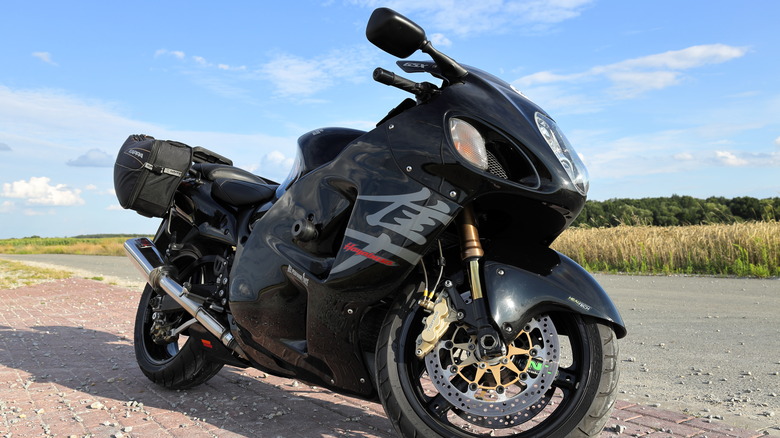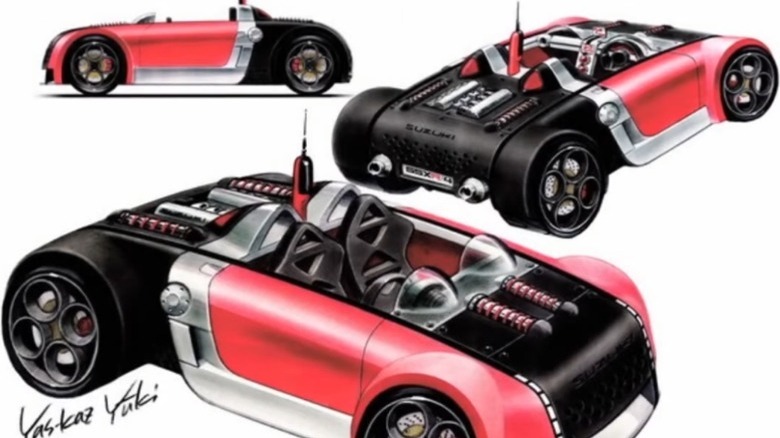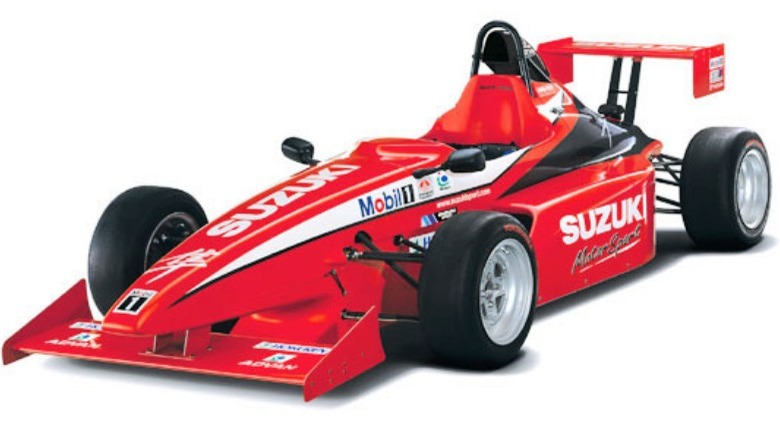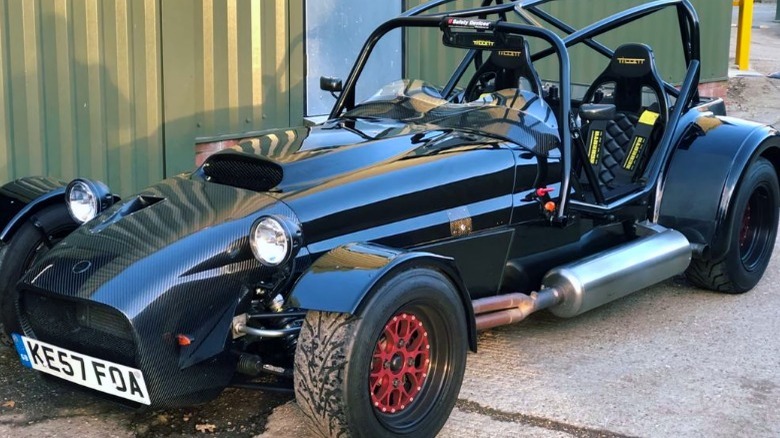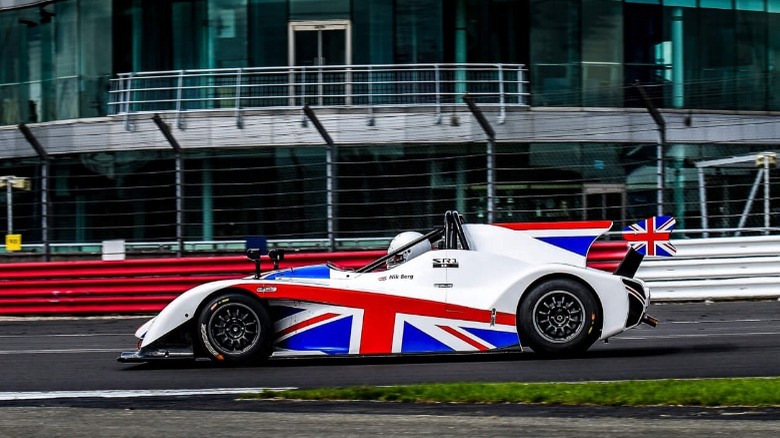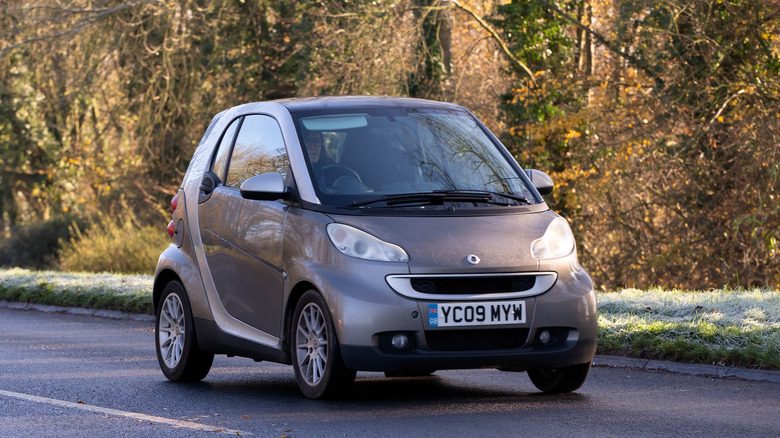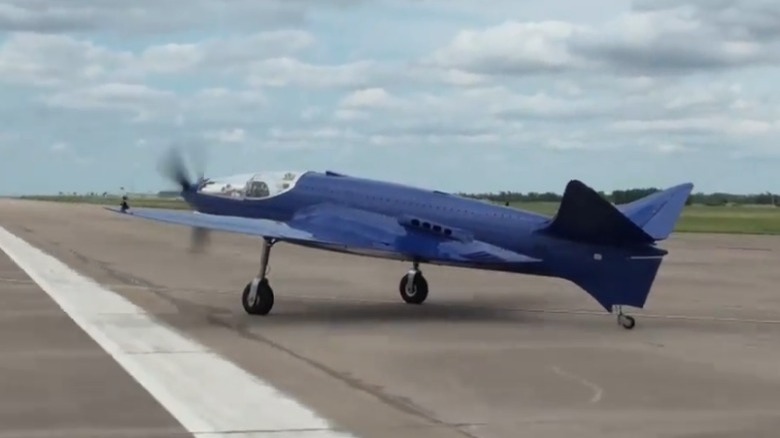6 Non-Motorcycle Vehicles Powered By The Hayabusa Engine
The Suzuki GSX1300R Hayabusa has been the company's flagship sports bike model ever since it was first introduced in 1999. This first model ran on a powerful 1,298cc, DOHC, liquid-cooled, 4-cylinder engine that could produce up to 175 horsepower at 9,800 RPM. This allowed the bike to go from 0-60 MPH in 2.6 seconds and reach a maximum speed that went over 190 MPH stock and was known to achieve speeds over 200 MPH with some modifications, handily beating Honda's CBR1100XX Super Blackbird and making the Hayabusa the world's fastest production motorcycle at the time.
The modern Hayabusa engine is even lighter and more powerful. It boasts a 1,340cc inline-4-cylinder, liquid-cooled, DOHC engine with all of Suzuki's latest performance-focused technology baked in, such as the Ride-by-Wire electronic throttle bodies, dual fuel injectors for each cylinder, and the Suzuki Ram Air Direct Intakes. It also doesn't hurt that it just-so-happens to be one of the coolest looking motorcycles that Suzuki ever made.
Given that these motorcycles have been at the cutting edge of performance technology for a quarter-century now, it might not surprise you too much to learn that several other vehicles have made use of this engine as well. What you might find more interesting is that many of them aren't motorcycles at all. The Hayabusa engine has been used in roadsters, racers, sports cars, subcompacts, and even planes.
Suzuki GSX-R/4 Roadster
You might expect most of the non-motorcycle vehicles that make use of the Hayabusa engine to be weird project cars that were designed in the garage of some creative and resourceful mechanic, but there are a couple of cars that used the engine which were actually designed by Suzuki itself. The first of these was the GSX-R/4 concept car which was revealed in 2001.
The name 'GSX-R/4' comes from the GSXR1300 engine that was powering it. It was a lightweight, aluminum-framed, 1,413 lb roadster with a low profile. The car was 139.8" long, 68.1" wide, and only 39.8" tall, with an almost toy-like rectangular profile. It had the Hayabusa engine mounted in the mid-rear and connected via a 6-speed transmission and a transfer unit which allowed the vehicle to drive in reverse. The little car might have looked funny to some, but the engine gave it an estimated maximum speed of 140 MPH.
The GSX-R/4 never entered commercial production, and few people ever had the opportunity to drive one. But funnily enough, it was featured in several of the games in the Gran Turismo video game franchise. This allowed fans who never would have had the opportunity to sit behind the wheel in real life to at least see how the Hayabusa-powered car handles in a virtual space.
Formula Hayabusa
The other car that Suzuki made using this motorcycle engine was the Formula Hayabusa racing car. This was a vehicle designed to represent one of the three categories in the One Make Race Series that was held in 2001. It was the top category at the event and was only accessible to expert drivers.
Like the other vehicles on this list, this Formula race car was powered by the GSXR1300 engine. This allowed the vehicle to attain 172.6 horsepower at 9,800 RPM and 101.8 lb-ft of torque at 7,000 RPM. It also made use of the motorcycle's 6-speed transmission, electronic engine management system, exhaust manifold, muffler, radiator, rearview mirrors and instrument panel. The Formula Hayabusa only sat one. It had an open cockpit and weighed just 948 lbs.
Some drivers praised the racer for its sporty handling and maneuverability, while others struggled with the amount of power under the hood. Scott Fisher of Army of Darkness stated, "The oversteer was pronounced, and the throttle was extremely sensitive. But the defining characteristic of the car was the motor. I couldn't really tell where the powerband began and ended, since it seemed like the car wanted to spin up and twist around as soon as you breathed on the throttle, no matter where you were in the RPM range."
Suzuki actually made these cars available to anyone who wished to purchase them in Suzuki dealerships located throughout Japan.
Westfield Megabusa
The Westfield Megabusa is an unusual sports car, to say the least. It's modeled after the Lotus Seven, which was the iconic first production vehicle built by trial car designer Colin Chapman in 1952. Some consider Westfield's interpretation to be much too dramatic to be a true reproduction of the Lotus Seven, as the Megabusa was a much sportier and more aerodynamically designed vehicle than the Seven it was modeled after. Westfield also offered a wide range of customization options, which meant that there was a lot of variance in the models that were produced, so two of the vehicles rarely looked alike. Even so, the Megabusa has piqued the interest of many classic car aficionados.
There are a few different generations of the Megabusa out there. Some of the later models ended up being powered by the Suzuki S4 engine, but the earlier editions were powered by the GSXR1300 Hayabusa Inline-4 –- putting the "busa" in Megabusa by granting it 178 horsepower at 9,800 RPM and 102 lb-ft of torque at 7,000 RPM. This allowed the Megabusa to go from 0-60 in 3.48 seconds and reach a top speed of 148 MPH.
Using a motorcycle engine might initially seem like a strange choice, but it makes a lot of sense when you consider what the Hayabusa engine is. It's a powerful, lightweight 4-cylinder engine with an inline orientation that suits the long and narrow hooded British sports car perfectly.
Radical Motorsport SR1
Another unique vehicle that made use of the Hayabusa engine is the Radical Motorsport SR1. Radical is a British manufacturer that is known for making both track and road sports cars. The original SR1 was a purely track-focused vehicle that was designed to be the entry-level option for new drivers. It was never meant to be street legal, and so it never had to make any of the concessions that usually go along with passing those associated restrictions. According to Motorsport Vision Racing, "While being Radical's 'entry level race car,' the SR1 is a full-on purpose-built race car generating lap times faster than GT4 cars costing three times as much."
The modern SR1 XXR that Radical currently sells is part of a second generation line that was revamped in 2017 and is powered by a Gen 5 RPE liquid cooled, in-line four, DOHC, 16 valve, 1,340cc engine, but the original model used the Hayabusa engine. Running on the motorcycle engine, the car was able to go from 0-60 in 3.6 seconds and could reach a reported top speed of 138 MPH.
Capitalizing on this performance, Radical Motorsports created a competition as part of the Hagerty Radical Cup UK race program called the Radical SR1 Cup Championship. This allowed aspiring racers to try their hand at the track while racing in the entry-level car.
SmartBusa ForTwo
For those who aren't familiar, Smart is a car company that was born of a partnership between the Swiss watch maker Swatch and Mercedes-Benz. It was discontinued in the U.S. back in 2019, but continues to make vehicles that are sold abroad. The company originally specialized in miniature two-seaters, such as the ForTwo, that were full of hidden features and had a distinctive subcompact appearance. These cars had nothing to do with Suzuki when they were manufactured, but aftermarket modders discovered that they work surprisingly well when outfitted with the Hayabusa engine.
Upon realizing this, a company called SmartBusa sought to take advantage of this compatibility. SmartBusa began selling modification kits that allowed Smart ForTwo owners to replace the vehicle's stock 600cc, 3-cylinder, turbo engine with the much more powerful 1,300R, 4-cylinder Suzuki one.
Jordan Butters of Speed Hunters was invited to take a look at another custom ForTwo during the Gatebil Rudskogen that was designed by Swiss hill climb champion Hans Schori and adapted to house the Hayabusa Engine by Heltec Engineering. "You are always in trouble in this car," Hans' son Yves told Butters. "We have a lot of experience in racing and drifting, but d***, this freaky little monster is a handful. You have up to 14,000rpm with boost from 3,000rpm. Let's just say the car is very aggressive because [the] wheelbase is very short and the power builds so quickly."
Bugatti 100P Replica
Most of the vehicles on this list have four wheels instead of two, but how many of them have wings? The Bugatti Model 100P Racer was a small, single-person aircraft that was developed in the 1930s to participate in the Deutsche de La Muerthe Cup Race. The frame was designed by notable Belgian engineer Louis de Monge, and it was built to accommodate two modified Bugatti model 50B engines. Sadly, the plane wasn't completed before the threat of German invasion forced Bugatti to move it into storage, and the plane was never flown.
Fast-forward to 2008 and retired Air Force fighter pilot Scotty Wilson decided to pick up where Bugatti and de Monge left off. Wilson's reconstruction took place in a hangar in Tulsa Oklahoma and ran a $400,000 tab (some of which was crowd-funded.) His Bugatti 100P replica made several changes from the original, incomplete design, but one of the most noteworthy alterations was his decision to swap out the two Bugatti model 50B engines for a pair of Suzuki Hayabusa motorcycle engines.
The plane made its debut flight on August 19, 2015, and it appeared to go well. Wilson himself reportedly referred to the test as "anti-climactic." It then made a second flight in October. Unfortunately, the third and final flight test which took place one year later on August 6, 2016, ended in tragedy. The plane crashed and Wilson lost his life.
